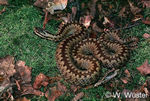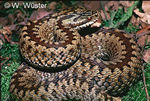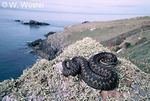|
Vipera berus
|
![Vipera berus ( European Viper ) [ Original photo copyright © Dr Wolfgang Wuster ]](images/snakes/SNP00671.jpg)
|
|
Family: Viperidae
|
|
Subfamily: Viperinae
|
|
Genus: Vipera
|
|
Species: berus
|
|
Subspecies: berus, sachalinensis
|
Common Names
European Viper , European Adder , Common Viper ( V. b berus ) , Sakhalin Island Viper ( V. b. sachalinensis ) , Sakhalinean Viper ( V. b. sachalinensis ) , Northern Viper
|
Local Names
Adder , Kreuzotter , Vipere peliade , Huggorm
|
Region
Europe + Russia + West Asia +North Asia
|
Countries
Austria, Belarus, Belgium, Bosnia and Herzegovina, Bulgaria, China, Croatia, Czechoslavakian Republic, Denmark, Estonia, Finland, France, Germany, Hungary, Italy, Kazakstan, North Korea, Latvia, Lithuania, Luxembourg, Macedonia, Moldova, Netherlands, Norway, Poland, Romania, Russia, Slovakia, Slovenia, Sweden, Switzerland, Ukraine, England, Scotland, Wales, Yugoslavia, Mongolia, United Kingdom
|
|

|
|
|
|
Taxonomy and Biology
|
|
Adult Length: 0.40 m
|
General Shape
Small in length, moderately thick bodied snake with a short tail. Can grow to a maximum of about 1.05 metres ( rarely exceeds 0.80 metres ). Head is more ovoid than triangular and distinct from neck with a flat, blunt snout which is not upturned. Eyes are medium in size with vertically elliptical pupils. Dorsal scales are strongly keeled ( first dorsal scale row may be smooth or weakly keeled ) with apical pits.
|
Habitat
Wide range of moist habitats including marshy meadows, forest, forest steppe and mountain terrain up to about 3000 metres. Restricted to higher altitudes in southern parts of its range.
|
Habits
Terrestrial, nocturnal during warmer months but diurnal in cooler months. Mild disposition, somewhat timid, but will strike quickly and repeatedly if cornered or provoked.
|
Prey
Feeds mainly on small mammals and occasionally lizards.
|
|
|
|
Venom
|
Average Venom Qty
6 to 18 mg ( dry weight ), U.S. Dept. Navy (1968) ( Ref : R000914 ).
10 to 18 mg ( dry weight ), Minton (1974) ( Ref : R000504 ).
|
General: Venom Neurotoxins
Possibly present but not clinically significant
|
General: Venom Myotoxins
Probably not present
|
General: Venom Procoagulants
Probably present
|
General: Venom Anticoagulants
Probably not present
|
General: Venom Haemorrhagins
Probably present
|
General: Venom Nephrotoxins
Probably not present
|
General: Venom Cardiotoxins
Probably not present
|
General: Venom Necrotoxins
Probably not present
|
General: Venom Other
Unknown
|
|
|
|
Clinical Effects
|
General: Dangerousness
Severe envenoming possible, potentially lethal
|
|
General: Rate of Envenoming: Unknown but likely to be moderate
|
|
General: Untreated Lethality Rate: Unknown but has caused deaths
|
General: Local Effects
Local pain, swelling, bruising & occasionally necrosis
|
General: Local Necrosis
Rarely occurs, usually minor only
|
General: General Systemic Effects
Variable non-specific effects which may include headache, nausea, vomiting, abdominal pain, diarrhoea, tachypnoea, respiratory distress, hypotension, dizziness, collapse or convulsions
|
General: Neurotoxic Paralysis
Rarely reported, usually minor
|
General: Myotoxicity
Does not occur, based on current clinical evidence
|
General: Coagulopathy & Haemorrhages
Uncommon to rare, but may be moderate to severe coagulopathy
|
General: Renal Damage
Rare, usually secondary effect
|
General: Cardiotoxicity
Does not occur, based on current clinical evidence
|
General: Other
Shock secondary to fluid shifts due to local tissue injury is likely in severe cases
|
|
|
|
First Aid
|
|
Description: First aid for bites by Viperid snakes likely to cause significant local injury at the bite site (see listing in Comments section).
|
Details
1. After ensuring the patient and onlookers have moved out of range of further strikes by the snake, the bitten person should be reassured and persuaded to lie down and remain still. Many will be terrified, fearing sudden death and, in this mood, they may behave irrationally or even hysterically. The basis for reassurance is the fact that many venomous bites do not result in envenoming, the relatively slow progression to severe envenoming (hours following elapid bites, days following viper bites) and the effectiveness of modern medical treatment.
2. The bite wound should not be tampered with in any way. Wiping it once with a damp cloth to remove surface venom is unlikely to do much harm (or good) but the wound must not be massaged.
3. All rings or other jewellery on the bitten limb, especially on fingers, should be removed, as they may act as tourniquets if oedema develops.
4. The bitten limb should be immobilised as effectively as possible using an extemporised splint or sling; if available, crepe bandaging of the splinted limb is an effective form of immobilisation.
5. If there is any impairment of vital functions, such as problems with respiration, airway, circulation, heart function, these must be supported as a priority. In particular, for bites causing flaccid paralysis, including respiratory paralysis, both airway and respiration may be impaired, requiring urgent and prolonged treatment, which may include the mouth to mask (mouth to mouth) technique of expired air transfer. Seek urgent medical attention.
6. Do not use Tourniquets, cut, suck or scarify the wound or apply chemicals or electric shock.
7. Avoid peroral intake, absolutely no alcohol. No sedatives outside hospital. If there will be considerable delay before reaching medical aid, measured in several hours to days, then give clear fluids by mouth to prevent dehydration.
8. If the offending snake has been killed it should be brought with the patient for identification (only relevant in areas where there are more than one naturally occurring venomous snake species), but be careful to avoid touching the head, as even a dead snake can envenom. No attempt should be made to pursue the snake into the undergrowth as this will risk further bites.
9. The snakebite victim should be transported as quickly and as passively as possible to the nearest place where they can be seen by a medically-trained person (health station, dispensary, clinic or hospital). The bitten limb must not be exercised as muscular contraction will promote systemic absorption of venom. If no motor vehicle or boat is available, the patient can be carried on a stretcher or hurdle, on the pillion or crossbar of a bicycle or on someone's back.
10. Most traditional, and many of the more recently fashionable, first aid measures are useless and potentially dangerous. These include local cauterization, incision, excision, amputation, suction by mouth, vacuum pump or syringe, combined incision and suction ("venom-ex" apparatus), injection or instillation of compounds such as potassium permanganate, phenol (carbolic soap) and trypsin, application of electric shocks or ice (cryotherapy), use of traditional herbal, folk and other remedies including the ingestion of emetic plant products and parts of the snake, multiple incisions, tattooing and so on.
|
|
|
|
Treatment
|
Treatment Summary
Bites may cause mild to severe local effects, shock & coagulopathy. All cases should be managed as potentially severe. Shock should be monitored for and vigorously treated. Specific antivenom is available only for some Vipera species, but should be used in all but minor envenoming cases.
|
Key Diagnostic Features
Local pain, swelling, bruising, shock, necrosis + coagulopathy, bleeding
|
General Approach to Management
All cases should be treated as urgent & potentially lethal. Rapid assessment & commencement of treatment including appropriate antivenom (if indicated & available) is mandatory. Admit all cases.
|
Antivenom Therapy
Antivenom is the key treatment for systemic envenoming. Multiple doses may be required.
|
| 1. Antivenom Code: SEuIZC01
|
|
Antivenom Name: Viper Venom Antitoxin, European
|
|
Manufacturer: Institute of Immunology, Inc.
|
|
Phone: ++385-1-468-4500
|
Address: PO Box 266
Rockefellerova Street 2
10000 Zagreb
|
|
Country: Croatia
|
| 2. Antivenom Code: SEuMHB01
|
|
Antivenom Name: Monovalent
|
|
Manufacturer: National Center of Infectious and Parasitic Diseases (Ministry of Health)
|
|
Phone: ++359-2-944-61-91
|
Address: 26, Yanko Sakasov Blvd.,
1504 Sofia,
|
|
Country: Bulgaria
|
| 3. Antivenom Code: SEuMIC02
|
|
Antivenom Name: ViperaTAb
|
|
Manufacturer: MicroPharm Ltd.
|
|
Phone: ++44-1239-710529
|
Address: Station Road Industrial Estate
Newcastle Emlyn
Carmarthenshire
SA38 9BY
United Kingdom
|
|
Country: United Kingdom
|
| 4. Antivenom Code: SEuIIV01
|
|
Antivenom Name: Viper Venom Antitoxin
|
|
Manufacturer: Torlak, Institute of Immunology and Virology
|
|
Phone: +381-11-3976-674
|
Address: 458 Vojvode Stepe St.
11152 Belgrade
P.O. Box 1, Serbia and Montenegro
|
|
Country: Yugoslavia
|
| 5. Antivenom Code: SEuSPM01
|
|
Antivenom Name: Viperfav
|
|
Manufacturer: Sanofi-Pasteur MSD
|
|
Phone: + 33 (0)4 37 28 40 00
|
|
Address: 8, rue Jonas Salk, 69367 Lyon Cedex 07
|
|
Country: France
|
|
|
|
Images
|

|

|

|
|
|
|
|
Vipera berus ( European Viper ) [ Original photo copyright © Dr Wolfgang Wuster ]
|
Vipera berus ( European Viper ) [ Original photo copyright © Dr Wolfgang Wuster ]
|
Vipera berus ( European Viper ) [ Original photo copyright © Dr Wolfgang Wuster ]
|
|
|
|
|
|
|



